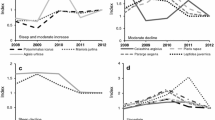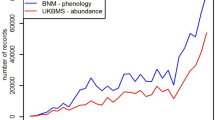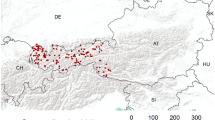Abstract
Butterflies are an important indicator of the impacts of environmental change. Butterfly monitoring schemes (BMS) have provided national and Europe-wide trends in their abundance and been widely used for research. Most schemes sample sites that are self-selected by contributors and therefore tend to cover locations that are rich in butterflies. To provide a more representative assessment of butterfly populations, the wider countryside butterfly survey (WCBS) was developed with a stratified-random sample of survey sites across the UK. We compare butterfly trends from the WCBS locations against those measured from traditional butterfly transects which are typically located in areas of good quality semi-natural habitats. Across the 26 species analysed, there was a significant positive relationship between trends measured from the two schemes between 2009 and 2013, the period when both schemes were operating fully. There was a tendency (17 out of 26 species analysed) for these changes to be greater within WCBS compared to traditional BMS transects, although this effect was not consistent across comparisons between pairs of consecutive years. When assessing these individual year-to-year changes, there was however a significant correlation between the two schemes in all cases. Over relatively short time periods, weather patterns are likely to dominate butterfly population fluctuations and lead to comparable trends across monitoring schemes. Over longer time periods, differences in land management may affect habitat condition differently for protected areas versus the wider countryside and it is therefore important to maintain comprehensive butterfly monitoring programmes to detect and interpret such effects.



Similar content being viewed by others
References
Brereton TM, Warren MS, Roy DB, Stewart K (2008) The changing status of the Chalkhill Blue butterfly Polyommatus coridon in the UK: the impacts of conservation policies and environmental factors. J Insect Conserv 12:629–638. doi:10.1007/s10841-007-9099-0
Brereton T, Roy DB, Middlebrook I, Botham M, Warren M (2011a) The development of butterfly indicators in the United Kingdom and assessments in 2010. J Insect Conserv 15:139–151. doi:10.1007/s10841-010-9333-z
Brereton TM, Cruickshanks KL, Risely K, Noble DG, Roy DB (2011b) Developing and launching a wider countryside butterfly survey across the United Kingdom. J Insect Conserv 15:279–290. doi:10.1007/s10841-010-9345-8
Carey P et al (2008) Countryside survey: UK results from 2007
CBD (2010) Decision X/2, The strategic plan for biodiversity 2011–2020 and the Aichi Biodiversity Targets, Nagoya, Japan, 18 to 29 October 2010. CBD, Nagoya
Chen I-C, Hill JK, Ohlemueller R, Roy DB, Thomas CD (2011) Rapid range shifts of species associated with high levels of climate warming. Science 333:1024–1026. doi:10.1126/science.1206432
Cowley MJR, Thomas CD, Thomas JA, Warren MS (1999) Flight areas of British butterflies: assessing species status and decline. Proc R Soc Lond B 266:1587–1592
Dempster JP, McLean I (1998) Insect populations: In theory and in practice: 19th symposium of the Royal Entomological Society, 10–11 September 1997 at the University of Newcastle, Kluwer Academic
Dennis RLH, Shreeve TG, Isaac N, Roy DB, Hardy PB, Fox R, Asher J (2006) The effects of visual apparency on bias in butterfly recording and monitoring. Biol Conserv 128:486–492
Dennis EB, Freeman SN, Brereton T, Roy DB (2013) Indexing butterfly abundance whilst accounting for missing counts and variability in seasonal pattern. Methods Ecol Evol 4:637–645
Fisher JA, Frank KT, Leggett WC (2010) Dynamic macroecology on ecological time-scales. Glob Ecol Biogeogr 19:1–15
Fox R, Asher J, Brereton T, Roy D, Warren M (2006) The state of butterflies in Britain and Ireland. Pisces, Newbury
Freeman SN, Noble DG, Newson SE, Baillie SR (2007) Modelling population changes using data from different surveys: the common birds census and the breeding bird survey. Bird Study 54:61–72
Freeman SN, Newson SE (2008) On a log-linear approach to detecting ecological interactions in monitored populations. Ibis 150:250–258
Gillingham PK, Alison J, Roy DB, Fox R, Thomas CD (2014) High abundances of species in protected areas in parts of their geographic distributions colonised during a recent period of climatic change. Conserv Lett. doi:10.1111/conl.12118
Gregory RD, van Strien A, Vorisek P, Meyling AWG, Noble DG, Foppen RPB, Gibbons DW (2005) Developing indicators for European birds. Philos Trans R Soc Lond Ser B Biol Sci 1454:269–288
Hickling R, Roy DB, Hill JK, Fox R, Thomas CD (2006) The distributions of a wide range of taxonomic groups are expanding polewards. Glob Change Biol 12:450–455
Hochachka WM, Fink D, Hutchinson RA, Sheldon D, Wong W-K, Kelling S (2012) Data-intensive science applied to broad-scale citizen science. Trends Ecol Evol 27:130–137
Matechou E, Dennis EB, Freeman SN, Brereton T (2014) Monitoring abundance and phenology in (multivoltine) butterfly species: a novel mixture model. J Appl Ecol 51:766–775
Miller-Rushing AJ, Primack RB (2008) Global warming and flowering times in thoreau’s concord: a community perspective. Ecology 89:332–341
Morton D et al (2011) Final report for LCM2007-the new UK land cover map. Countryside survey technical report no 11/07
Oliver TH, Morecroft MD (2014) Interactions between climate change and land use change on biodiversity: attribution problems, risks, and opportunities. Wiley Interdiscip Rev Clim Chang 5:317–335. doi:10.1002/wcc.271
Oliver T, Hill JK, Thomas CD, Brereton T, Roy DB (2009) Changes in habitat specificity of species at their climatic range boundaries. Ecol Lett 12:1091–1102. doi:10.1111/j.1461-0248.2009.01367.x
Oliver TH et al (2012a) Population density but not stability can be predicted from species distribution models. J Appl Ecol 49:581–590. doi:10.1111/j.1365-2664.2012.02138.x
Oliver TH, Roy DB, Brereton T, Thomas JA (2012b) Reduced variability in range-edge butterfly populations over three decades of climate warming. Glob Chang Biol 18:1531–1539
Oliver TH, Thomas CD, Hill JK, Brereton T, Roy DB (2012c) Habitat associations of thermophilous butterflies are reduced despite climatic warming. Glob Chang Biol 18:2720–2729. doi:10.1111/j.1365-2486.2012.02737.x
Oliver TH, Brereton T, Roy DB (2013) Population resilience to an extreme drought is influenced by habitat area and fragmentation in the local landscape. Ecography 36:579–586. doi:10.1111/j.1600-0587.2012.07665.x
Pagel J et al (2014) Quantifying range-wide variation in population trends from local abundance surveys and widespread opportunistic occurrence records. Methods Ecol Evol 5:751–760. doi:10.1111/2041-210X.12221
Pe’er G et al (2014) EU agricultural reform fails on biodiversity. Science 344:1090–1092. doi:10.1126/science.1253425
Pereira HM et al (2010) Global biodiversity monitoring. Front Ecol Environ 8:459–460
Pereira HM, Navarro LM, Martins IS (2012) Global biodiversity change: the bad, the good, and the unknown. Annu Rev Environ Resour 37:25–50. doi:10.1146/annurev-environ-042911-093511
Pereira HM et al (2013) Essential biodiversity variables. Science 339:277–278
Pollard E (1977) A method of assessing changes in the abundance of butterflies. Biol Conserv 12:115–134
Pollard E, Yates TJ (1994) Monitoring butterflies for ecology and conservation: the British butterfly monitoring scheme. Springer
Powney G, Roy D, Chapman D, Oliver T (2010) Synchrony of butterfly populations across species’ geographic ranges. Oikos 119:1690–1696. doi:10.1111/j.1600-0706.2010.18168.x
Pywell RF, Heard MS, Bradbury RB, Hinsley S, Nowakowski M, Walker KJ, Bullock JM (2012) Wildlife-friendly farming benefits rare birds, bees and plants. Biol Lett 8:772–775
Rothery P, Roy DB (2001) Application of generalized additive models to butterfly transect count data. J Appl Stat 28:897–909
Roy DB, Thomas JA (2003) Seasonal variation in the niche, habitat availability and population fluctuations of a bivoltine thermophilous insect near its range margin. Oecologia 134:439–444
Roy DB, Rothery P, Moss D, Pollard E, Thomas JA (2001) Butterfly numbers and weather: predicting historical trends in abundance and the future effects of climate change. J Anim Ecol 70:201–217
Roy DB, Rothery P, Brereton T (2007) Reduced-effort schemes for monitoring butterfly populations. J Appl Ecol 44:993–1000
Strong DR, Lawton JH, Southwood SR (1984) Insects on plants. Community patterns and mechanisms. Blackwell Scientific Publicatons, Oxford
Thomas JA (2005) Monitoring change in the abundance and distribution of insects using butterflies and other indicator groups. Philos Trans R Soc B Biol Sci 360:339–357
Thomas JA, Clarke RT (2004) Extinction rates and butterflies. Science 305:1563–1564
Thomas JA et al (2004) Comparative losses of British butterflies, birds, and plants and the global extinction crisis. Science 303:1879–1881
Thomas CD et al (2012) Protected areas facilitate species’ range expansions. Proc Natl Acad Sci USA 109:14063–14068. doi:10.1073/pnas.1210251109
Warren MS et al (2001) Rapid responses of British butterflies to opposing forces of climate and habitat change. Nature 414:65–69
Woodcock BA, Bullock JM, Mortimer SR, Brereton T, Redhead JW, Thomas JA, Pywell RF (2012) Identifying time lags in the restoration of grassland butterfly communities: a multi-site assessment. Biol Conserv 155:50–58
Acknowledgments
The UKBMS is operated by the Centre for Ecology and Hydrology, Butterfly Conservation and the British Trust for Ornithology and funded by a multi-agency consortium including the Countryside Council for Wales, Defra, the Joint Nature Conservation Committee, Forestry Commission, Natural England, the Natural Environment Research Council, and Scottish Natural Heritage. The UKBMS is indebted to all volunteers who contribute data to the scheme. We thank two anonymous referees for helpful comments on this manuscript.
Author information
Authors and Affiliations
Corresponding author
Rights and permissions
About this article
Cite this article
Roy, D.B., Ploquin, E.F., Randle, Z. et al. Comparison of trends in butterfly populations between monitoring schemes. J Insect Conserv 19, 313–324 (2015). https://doi.org/10.1007/s10841-014-9739-0
Received:
Accepted:
Published:
Issue Date:
DOI: https://doi.org/10.1007/s10841-014-9739-0




